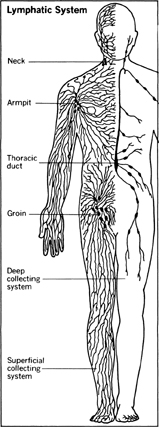The Circulatory System, the Heart, and Blood - Lymph and the lymphatic system
Of all our body systems, perhaps the most ignored is the lymphatic system, although it forms a network throughout our body comparable to the blood vessels of our circulatory system.
Lymph is a whitish fluid that is derived from blood plasma. As plasma circulates through the body, some of it seeps through the walls of capillaries and other blood vessels. This leakage is of the utmost importance, because the leaked fluid, lymph, supplies the liquid environment around and between individual cells and tissues that is essential for their survival.
The presence of lymph requires a drainage system to keep the fluid moving. If there were no drainage system, two things could happen: the dammed-up lymph could create areas swollen with water in which cells would literally drown, or stagnant pools of lymph could become breeding grounds for infection.
As it moves through the vessels of the lymphatic system, lymph carries away from the tissues the bits and pieces of cells that have died and disintegrated, and also potentially harmful bacteria and viruses.
Lymph and Lymphocytes
Confusion often arises about the connection between the white blood cells called lymphocytes and the lymph itself. Lymph is not made up of lym phocytes, although it often carries them; lymph is simply a watery vehicle moving through the lymphatic network. At certain points along this network, the vessels enlarge into clumpy structures called lymph nodes (or, misleadingly, lymph glands). Lymph nodes are major manufacturing sites for lymphocytes.

Lymph Nodes
Swollen glands are actually swollen lymph nodes, where a small army of lymphocytes is doing battle against invading bacteria or other harmful microscopic organisms. The lymph nodes, more than a hundred of them distributed around the body, serve as defense outposts against germs approaching the interior of the body. Those in the neck, groin, and armpits most frequently exhibit the pain and swelling that may accompany germ-fighting.
Circulation of Lymph
Lymph circulates without any help from the heart. From the spaces between cells, it diffuses into lymph capillaries which, like the venous capillaries, merge into larger and larger vessels moving inward toward the heart. The lymph moves—even upward from the legs and lower part of the body—because the muscles and movements of the body are constantly kneading and squeezing the lymph vessels. These vessels are equipped with valves that prevent back-flow. This is not so very different from the way venous blood makes its way back to the heart.
Eventually, master lymph vessels from the head, abdomen, and torso join in the thoracic lymph duct, which then empties into large neck veins that carry lymph and venous blood, mixed together, back to the heart.

Comment about this article, ask questions, or add new information about this topic: